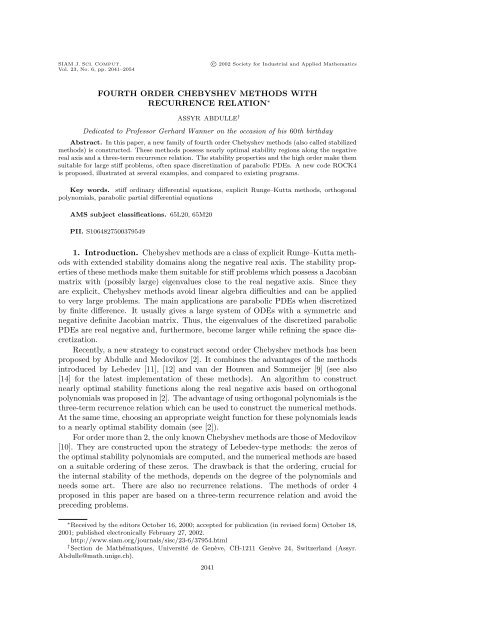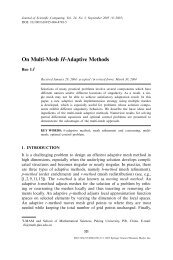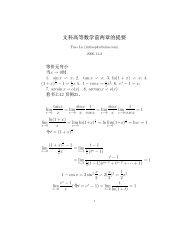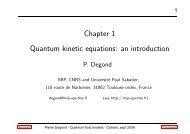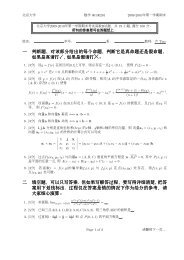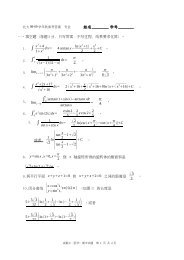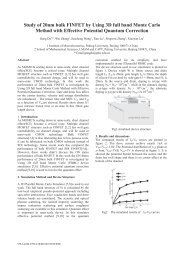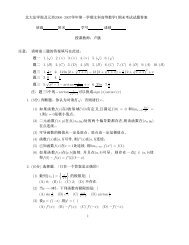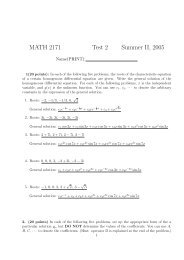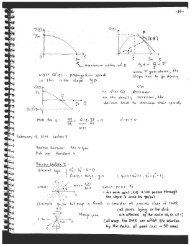fourth order chebyshev methods with recurrence relation
fourth order chebyshev methods with recurrence relation
fourth order chebyshev methods with recurrence relation
Create successful ePaper yourself
Turn your PDF publications into a flip-book with our unique Google optimized e-Paper software.
SIAM J. SCI. COMPUT. c○ 2002 Society for Industrial and Applied Mathematics<br />
Vol. 23, No. 6, pp. 2041–2054<br />
FOURTH ORDER CHEBYSHEV METHODS WITH<br />
RECURRENCE RELATION ∗<br />
ASSYR ABDULLE †<br />
Dedicated to Professor Gerhard Wanner on the occasion of his 60th birthday<br />
Abstract. In this paper, a new family of <strong>fourth</strong> <strong>order</strong> Chebyshev <strong>methods</strong> (also called stabilized<br />
<strong>methods</strong>) is constructed. These <strong>methods</strong> possess nearly optimal stability regions along the negative<br />
real axis and a three-term <strong>recurrence</strong> <strong>relation</strong>. The stability properties and the high <strong>order</strong> make them<br />
suitable for large stiff problems, often space discretization of parabolic PDEs. A new code ROCK4<br />
is proposed, illustrated at several examples, and compared to existing programs.<br />
Key words. stiff ordinary differential equations, explicit Runge–Kutta <strong>methods</strong>, orthogonal<br />
polynomials, parabolic partial differential equations<br />
AMS subject classifications. 65L20, 65M20<br />
PII. S1064827500379549<br />
1. Introduction. Chebyshev <strong>methods</strong> are a class of explicit Runge–Kutta <strong>methods</strong><br />
<strong>with</strong> extended stability domains along the negative real axis. The stability properties<br />
of these <strong>methods</strong> make them suitable for stiff problems which possess a Jacobian<br />
matrix <strong>with</strong> (possibly large) eigenvalues close to the real negative axis. Since they<br />
are explicit, Chebyshev <strong>methods</strong> avoid linear algebra difficulties and can be applied<br />
to very large problems. The main applications are parabolic PDEs when discretized<br />
by finite difference. It usually gives a large system of ODEs <strong>with</strong> a symmetric and<br />
negative definite Jacobian matrix. Thus, the eigenvalues of the discretized parabolic<br />
PDEs are real negative and, furthermore, become larger while refining the space discretization.<br />
Recently, a new strategy to construct second <strong>order</strong> Chebyshev <strong>methods</strong> has been<br />
proposed by Abdulle and Medovikov [2]. It combines the advantages of the <strong>methods</strong><br />
introduced by Lebedev [11], [12] and van der Houwen and Sommeijer [9] (see also<br />
[14] for the latest implementation of these <strong>methods</strong>). An algorithm to construct<br />
nearly optimal stability functions along the real negative axis based on orthogonal<br />
polynomials was proposed in [2]. The advantage of using orthogonal polynomials is the<br />
three-term <strong>recurrence</strong> <strong>relation</strong> which can be used to construct the numerical <strong>methods</strong>.<br />
At the same time, choosing an appropriate weight function for these polynomials leads<br />
to a nearly optimal stability domain (see [2]).<br />
For <strong>order</strong> more than 2, the only known Chebyshev <strong>methods</strong> are those of Medovikov<br />
[10]. They are constructed upon the strategy of Lebedev-type <strong>methods</strong>: the zeros of<br />
the optimal stability polynomials are computed, and the numerical <strong>methods</strong> are based<br />
on a suitable <strong>order</strong>ing of these zeros. The drawback is that the <strong>order</strong>ing, crucial for<br />
the internal stability of the <strong>methods</strong>, depends on the degree of the polynomials and<br />
needs some art. There are also no <strong>recurrence</strong> <strong>relation</strong>s. The <strong>methods</strong> of <strong>order</strong> 4<br />
proposed in this paper are based on a three-term <strong>recurrence</strong> <strong>relation</strong> and avoid the<br />
preceding problems.<br />
∗Received by the editors October 16, 2000; accepted for publication (in revised form) October 18,<br />
2001; published electronically February 27, 2002.<br />
http://www.siam.org/journals/sisc/23-6/37954.html<br />
† Section de Mathématiques, Université de Genève, CH-1211 Genève 24, Switzerland (Assyr.<br />
Abdulle@math.unige.ch).<br />
2041
2042 ASSYR ABDULLE<br />
The paper is organized as follows. In section 2 we explain how to compute nearly<br />
optimal <strong>fourth</strong> <strong>order</strong> stability polynomials. Section 3 is devoted to the construction<br />
of a family of numerical <strong>methods</strong>. These <strong>methods</strong> have been implemented in a new<br />
code called ROCK4 which is briefly described in section 4. Finally, in section 5 we<br />
present some numerical experiments and comparisons <strong>with</strong> other codes.<br />
2. Fourth <strong>order</strong> stability polynomials. The aim is to construct a family of<br />
polynomials of <strong>order</strong> 4 depending on the degree s, 1<br />
Rs(z) =1+z + z2 z3 z4<br />
+ +<br />
2! 3! 4! + O(z5 (2.1)<br />
),<br />
which remain bounded by 1 as long as possible along the real negative axis, i.e.,<br />
(2.2)<br />
| Rs(z)| ≤1 for z ∈ [− ls, 0],<br />
<strong>with</strong> ls as large as possible. It is proved in [1] that <strong>fourth</strong> <strong>order</strong> optimal stability<br />
polynomials (which exist and are unique see [13]) possess exactly four complex zeros.<br />
Thus, they can be written as<br />
(2.3)<br />
Rs(z) = w4(z) Ps−4(z),<br />
where w4(z) =(1−/t1)(1−/¯t1)(1−/t2)(1−/¯t2), ti are complex (conjugate) numbers,<br />
and Ps−4(z) possesses only real zeros. The idea developed in [2] for second <strong>order</strong> is<br />
to approximate these polynomials by<br />
(2.4)<br />
Rs(z) =w4(z)Ps−4(z),<br />
where w4(z) =(1− /z1)(1 − /¯z1)(1 − /z2)(1 − /¯z2) and Ps−4(z) is an orthogonal<br />
polynomial associated <strong>with</strong> the weight function w4(z) 2 / √ 1 − z 2 . Wewanttofind<br />
such a decomposition which satisfies (2.2) for z ∈ [−ls, 0] <strong>with</strong> ls close to ls. At the<br />
same time, we want that the product satisfies the <strong>fourth</strong> <strong>order</strong> conditions (2.1).<br />
The motivation for considering such polynomials can be found in [2]. Notice that<br />
for first <strong>order</strong> optimal polynomials we have a formula similar to (2.3), <strong>with</strong> w(z) =1<br />
and Rs(z) =Ts(1 + z<br />
s 2 ), where Ts(z) are the Chebyshev polynomials. These optimal<br />
polynomials are at the same time orthogonal <strong>with</strong> respect to the weight function<br />
1/ √ 1 − z 2 . The arguments developed in [2] show that for <strong>order</strong> 2 the polynomials<br />
(2.3) and (2.4) are very close. These arguments can be generalized for even <strong>order</strong>s<br />
higher than 2. Figure 2.1 shows for s = 9 the difference between a <strong>fourth</strong> <strong>order</strong><br />
optimal stability polynomial and its approximation. We see that they can hardly be<br />
distinguished.<br />
For second <strong>order</strong>, the algorithm for computing the orthogonal polynomials and<br />
the zeros of the function w(z) of (2.4) was given in [2]. We adapt here this algorithm<br />
for <strong>order</strong> 4.<br />
In the following we will work in the normalized interval [−1, 1] instead of [−ls, 0]<br />
by setting x =1+ 2z<br />
ls (ls is the length of the stability domain along R − we want to<br />
optimize), and we take the same notation for the shifted polynomials except for the<br />
fact that we use the variable x instead of z. Thus, we are searching for <strong>order</strong> 4 at<br />
x = 1 (see below). If we shift the polynomials defined by (2.4) and normalize them<br />
1 We use the notation Rs because we reserve Rs for the stability polynomials we will construct.
FOURTH ORDER CHEBYSHEV METHODS 2043<br />
0<br />
−20 −10 0<br />
1<br />
−1<br />
Fig. 2.1. R9(x) and its stability domain, <strong>with</strong> R9(x) in the dotted line, η =0.95 (damping).<br />
such that |w4(x)Ps−4(x)| ≤1 for x ∈ [−1, 1], then w4(1)Ps−4(1) is usually not equal<br />
to 1. As in [2], we therefore introduce a parameter a close to 1, set<br />
(2.5)<br />
Rs(x) = w4(x)Ps−4(x)<br />
w4(a)Ps−4(a) ,<br />
and we search <strong>fourth</strong> <strong>order</strong> conditions at the point a. We denote the complex zeros<br />
of w4(x) byx1 = α + iβ, ¯x1 = α − iβ, x2 = γ + iδ, ¯x2 = γ − iδ, and to emphasize<br />
the dependence of Rs(x) onα, β, γ, δ we will write Rs(x, α, β, γ, δ). We have now an<br />
optimization problem.<br />
Problem. Find a, d, α, β, γ, δ (depending on s) such that<br />
(2.6)<br />
(2.7)<br />
(2.8)<br />
(2.9)<br />
R ′ s(a, α, β, γ, δ) =d, R ′′<br />
s (a, α, β, γ, δ) =d 2 ,<br />
R ′′′<br />
s (a, α, β, γ, δ) =d 3 , R (4)<br />
s (a, α, β, γ, δ) =d 4 ,<br />
|Rs(x)| ≤1 for x ∈ [−1,a]<br />
If we then set z =(x − a)/d, we will have<br />
(2.10)<br />
(2.11)<br />
<strong>with</strong> ls =(1+a)d as large as possible.<br />
−10<br />
Rs(0)=1, R ′ s(0)=1, R ′′<br />
s (0)=1, R ′′′<br />
s (0)=1, R (4)<br />
s (0)=1,<br />
|Rs(z)| ≤1 for z ∈ [−ls, 0].<br />
Here again we used the same notation for the shifted polynomials. For more details<br />
about this algorithm we refer the reader to [2].<br />
We have computed the parameters ls,α,β,γ,δ,a (depending on s) for degree 5<br />
up to degree more than 1000. In practice the bound in (2.8) should be replaced by<br />
a value η
2044 ASSYR ABDULLE<br />
Table 2.1<br />
The stability parameters of Rs(x).<br />
Degree Stability Value Degree Stability Value<br />
s region ls c(s) =ls/s 2 s region ls c(s) =ls/s 2<br />
5 5.9983 0.239931 100 3538.1276 0.353813<br />
10 32.4470 0.324470 250 22184.4995 0.354952<br />
20 138.3586 0.345897 500 88746.9995 0.354988<br />
50 879.8864 0.351955 750 199684.4999 0.354995<br />
3. Fourth <strong>order</strong> Chebyshev <strong>methods</strong>. In the preceding section we have explained<br />
how to compute our stability polynomials. Assume now that we have such a<br />
family of <strong>fourth</strong> <strong>order</strong> polynomials (depending on the degree s)<br />
(3.1)<br />
which satisfy<br />
(3.2)<br />
Rs(z) =w4(z)Ps−4(z),<br />
|Rs(z)| ≤1 for z ∈ [−ls, 0],<br />
where w4(z) =(1− /z1)(1 − /¯z1)(1 − /z2)(1 − /¯z2) and Ps−4(z) is an orthogonal<br />
polynomial associated <strong>with</strong> the weight function<br />
(3.3)<br />
w4(z) 2 / 1 − z 2 ,<br />
and normalized such that Ps−4(0) = 1. For a given degree s we will further use the<br />
family of orthogonal polynomials (Pj) s−4<br />
j=0 associated <strong>with</strong> the weight function (3.3),<br />
normalized such that Pj(0) = 1. These polynomials possess a three-term <strong>recurrence</strong><br />
<strong>relation</strong><br />
Pj(z) =(µjz − νj)Pj−1(z) − κjPj−2(z).<br />
In [2] it was explained how to compute explicitly these polynomials, given the zeros<br />
of the function (3.3). The same procedure can be applied here, and the <strong>recurrence</strong><br />
coefficients can be computed simply by solving a linear system.<br />
For second <strong>order</strong> <strong>methods</strong>, it is sufficient to construct a numerical method which<br />
is of <strong>order</strong> 2 for linear problems, since the <strong>order</strong> conditions are the same for both linear<br />
and nonlinear problems. This is not true for <strong>order</strong>s larger than 2, and it is therefore<br />
not sufficient to consider only the linear case. Here we have to give a realization of our<br />
weight function w4(z) so that the <strong>order</strong> conditions up to <strong>order</strong> 4 (8 conditions) are<br />
satisfied. As in [10] we will use the theory of composition of <strong>methods</strong> (the “Butcher<br />
group”) to realize <strong>fourth</strong> <strong>order</strong> Runge–Kutta–Chebyshev <strong>methods</strong>.<br />
Suppose that we have two Runge–Kutta <strong>methods</strong>. The idea of composition of<br />
<strong>methods</strong> is to apply one method after the other to an initial value y0 <strong>with</strong> the same<br />
step size. The result of this process can be interpreted as a large Runge–Kutta<br />
method: a composition of the two latter <strong>methods</strong>. For the theory of composition of<br />
Runge–Kutta <strong>methods</strong>, we refer to [3],[6, pp. 264–273],[5].<br />
To construct a <strong>fourth</strong> <strong>order</strong> Runge–Kutta method <strong>with</strong> the polynomials (3.1) we<br />
proceed as follows:<br />
• We construct a first method, denoted by P , which possesses Ps−4(z) as stability<br />
polynomial.<br />
• We then determine a second method, denoted by W , which possesses w4(z)<br />
as stability polynomial, to achieve <strong>fourth</strong> <strong>order</strong> for the “composite” method<br />
denoted by WP.
0<br />
c2<br />
.<br />
a21<br />
.<br />
FOURTH ORDER CHEBYSHEV METHODS 2045<br />
. ..<br />
cs−4 as−4,1 ... as−4,s−5<br />
b1 ... bs−5<br />
bs−4<br />
0<br />
c2 a21<br />
c3 a31 a32<br />
c4 a41 a42 a43<br />
Fig. 3.1. Tableau of the method P (left) and W (right).<br />
The resulting method will be of <strong>order</strong> 4 and will possess Rs(z) =w4(z)Ps−4(z) as<br />
stability polynomial.<br />
Thefirst method. To construct the method P we apply a procedure similar<br />
to that used in [2]. That is, the three-term <strong>recurrence</strong> <strong>relation</strong> of the orthogonal<br />
is used to define the internal stages of the method as follows:<br />
polynomials (Pj) s−4<br />
j=1<br />
(3.4)<br />
g0 := y0,<br />
g1 := y0 + hµ1f(g0),<br />
gj := hµjf(gj−1) − νjgj−1 − κjgj−2, j =2,... ,s− 4,<br />
y1 := gs−4.<br />
Applied to y ′ = λy <strong>with</strong> z = hλ yields<br />
(3.5)<br />
gs−4 = Ps−4(z)g0.<br />
This method is given in the left tableau of Figure 3.1. The coefficients of the method<br />
P can be expressed recursively in term of the coefficients νj,µj,κj. Indeed, using the<br />
notation ki = f(y0 + h i−1<br />
j=1 aijkj) (autonomous form), we obtain for the first stage<br />
(3.6)<br />
g1 = y0 + hµ1f(y0) =y0 + ha21k1;<br />
this yields a21 = µ1. For the second stage we have<br />
(3.7)<br />
g2 =<br />
=<br />
hµ2f(y0 + ha21k1) − ν2(y0 + ha21k1) − κ2y0<br />
y0(−ν2 − κ2)+h(−ν2a21)k1 + hµ2k2;<br />
hence a31 = −ν2a21 and a32 = µ2. (Notice that −ν2 − κ2 = 1 because of the<br />
normalization Pj(0) = 1.) The third stage is then given by<br />
g3 = hµ3f(y0 + h(ã31k1 +ã32k2)) − ν3(y0 + h(ã31k1 +ã32k2)) − κ3(y0 + hã21k1)<br />
= y0(−ν3 − κ3)+h(−ν3ã31 − κ3ã21)k1 + h(−ν3ã32)k2 + hµ3k3,<br />
and thus ã41 = −ν3ã31 − κ3ã21, ã42 = −ν3ã32 and ã43 = µ3. By induction we obtain<br />
the following lemma.<br />
Lemma 3.1. For the method P given by (3.4) the coefficients aij, bi, ci of the<br />
corresponding Runge–Kutta method are given by<br />
(3.8)<br />
ai,j = −νi−1ai−1,j − κi−1ai−2,j, j ≤ i − 2, i ≤ s − 3(ajj := 0),<br />
ai,i−1<br />
bj =<br />
=<br />
µi−1,<br />
as−3,j,<br />
i ≤ s − 3,<br />
1 ≤ j ≤ s − 4,<br />
and the ci satisfy the usual <strong>relation</strong> ci = i−1<br />
j=1 aij.<br />
We emphasize that the coefficients ãij, ˜ bi will be used only to compute the method<br />
W . For the implementation of the method, formulas (3.4) will be used.<br />
b1<br />
b2<br />
b3<br />
b4
2046 ASSYR ABDULLE<br />
0<br />
c2<br />
.<br />
a21<br />
.<br />
. ..<br />
cs−4 as−4,1 ... as−4,s−5<br />
<br />
bi b1 ... bs−3 <br />
bi + c2<br />
b1 ... bs−3 .<br />
<br />
bi + c4<br />
.<br />
b1 ... bs−3<br />
b1 ... bs−3<br />
bs−4<br />
bs−4 a21<br />
. ..<br />
bs−4 a41 ... a43<br />
bs−4<br />
Fig. 3.2. Tableau of method WP.<br />
b1 ... b3<br />
The second and the “composite” <strong>methods</strong>. For the method W we take a<br />
<strong>fourth</strong> stage method (right tableau of Figure 3.1) so that the composite method WP is<br />
given by Figure 3.2. In the tableau of method WP, we will denote by ci the elements<br />
of the first column, by aij the elements of the “triangle,” and by bi the elements of<br />
the last row. The <strong>order</strong> conditions of the method WP are the usual ones for <strong>order</strong> 4:<br />
(3.9)<br />
wp( ) = bi = 1,<br />
wp( / ) = 2 biaij = 1,<br />
wp( \ /<br />
) = 3 wp( /<br />
biaijaik = 1,<br />
\<br />
<br />
<br />
) =<br />
<br />
6 biaijajk = 1,<br />
wp( \ |/ <br />
) = 4 wp( /<br />
biaijaikail = 1,<br />
\<br />
<br />
<br />
\ ) = 8 wp( /<br />
biaijajkail = 1,<br />
\/<br />
<br />
) = 12 wp( /<br />
biaijajkajl = 1,<br />
\<br />
<br />
/ <br />
) = 24 biaijajkakl = 1.<br />
Here we used the trees notation (connected graphs <strong>with</strong>out cycles and a distinguished<br />
vertex) for the elementary weights (wp(...)) involved in the <strong>order</strong> conditions (see [6,<br />
pp. 145–154] or [3]).<br />
Theorem 12.6 of [6, p. 267] can be used to express the <strong>order</strong> conditions of the<br />
method WP in function of the two sub<strong>methods</strong>, W and P . See also [5] for a new<br />
simple proof of this latter theorem (<strong>with</strong> another normalization for the elementary<br />
weights). We obtain<br />
wp( ) = w( )+p( ),<br />
wp( / ) = w( / )+2w( )p( )+p( / ),<br />
wp( \ /<br />
) = w( \ /<br />
)+3w( / )p( )+3w( )p( ) 2 + p( \ /<br />
wp( /<br />
),<br />
\<br />
<br />
<br />
) =<br />
\<br />
w( / <br />
<br />
)+3w( / )p( )+3w( )p( / )+p( / \<br />
<br />
<br />
),<br />
wp( \ |/ <br />
) = w( \ |/ <br />
)+4w( \ /<br />
)p( )+6w( / )p( ) 2 +4w( )p( ) 3 + p( \ |/ <br />
),<br />
b4
FOURTH ORDER CHEBYSHEV METHODS 2047<br />
w( /\ <br />
<br />
2 )p( )+<br />
<br />
\ )p( ))+6( 1<br />
3w( / )p( / )+ 2<br />
3w( / )p( ) 2 )<br />
wp( / \<br />
\ ) = w( / \<br />
\ )+4( 1<br />
3 3w( /<br />
+4w( )p( )p( / )+p( / \<br />
<br />
<br />
\ ),<br />
wp( / \/<br />
<br />
) = w( / \/<br />
<br />
)+4w( / \<br />
<br />
<br />
)p( )+6w( / )p( ) 2 +4w( )p( \ /<br />
)+p( / \/<br />
<br />
wp( / \<br />
<br />
/ <br />
) = w( / \<br />
<br />
/ <br />
)+4w( / \<br />
<br />
<br />
)p( )+6w( / )p( / )+4w( )p( / \<br />
<br />
\<br />
)+p( / <br />
/ <br />
where w(...) and p(...) are the expressions (3.9) for the <strong>methods</strong> W and P , respectively.<br />
These formulas allow us to compute recursively the expressions w( ),w(/ ),...<br />
for the method W , since the expressions p( ),p(/ ),... can be computed <strong>with</strong> the coefficients<br />
of the method P given by (3.8). This leads to the following equations for<br />
the method W :<br />
(3.10)<br />
b1 + b2 + b3 + b4 = w( ),<br />
b2c2 + b3c3 + b4c4 = w(/ )<br />
2 ,<br />
b2c 2 2 + b3c 2 3 + b4c 2 <br />
w( /<br />
4 =<br />
\ )<br />
3 ,<br />
b3a32c2 + w( /\<br />
b4(a42c2 + a43c3) = <br />
<br />
)<br />
6 ,<br />
b2c 3 2 + b3c 3 3 + b4c 3 4 = w( \ |/ <br />
)<br />
4 ,<br />
b3c3a32c2 + b4c4(a42c2 + a43c3) =<br />
b3a32c 2 2 + b4(a42c 2 2 + a43c 2 3) =<br />
b4a43a32c2 =<br />
<br />
<br />
w( \ /\ )<br />
8 ,<br />
w( /\/ <br />
)<br />
12 ,<br />
<br />
/ <br />
w( /\ )<br />
24 .<br />
This is a system of 8 equations for 10 unknowns bi, aij (ci are determined by ci =<br />
i−1<br />
j=1 aij.) These equations are similar to the equations of usual <strong>fourth</strong> <strong>order</strong> <strong>methods</strong><br />
(i.e., when w( ) =1,w(/ )=1, ...; see [6, pp. 135–136]). We have two degrees of<br />
freedom, and we choose c3 =<br />
w( )<br />
3<br />
and c4 =<br />
2w( )<br />
3<br />
),<br />
after some experimentation. This<br />
choice keeps the absolute value of the coefficients bi, aij less than 1, which is suitable<br />
for a numerical method.<br />
The solution of equations (3.10) gives us the coefficients of the method W . Thus,<br />
we have obtained a family of <strong>methods</strong> (depending on the degree of the stability polynomial)<br />
of <strong>order</strong> 4 <strong>with</strong> <strong>recurrence</strong> formulas and <strong>with</strong> the polynomial (3.1) as a stability<br />
function.<br />
The embedded method. For the estimation of the local error of the constructed<br />
numerical method<br />
⎛<br />
⎞<br />
(3.11)<br />
s<br />
i−1<br />
y1 = y0 + h bif ⎝y0 + h<br />
s<br />
⎠ = y0 + h biki,<br />
i=1<br />
j=1<br />
aijkj<br />
we use an embedded method of <strong>order</strong> 3.<br />
Since for <strong>fourth</strong> <strong>order</strong> <strong>methods</strong> there is no embedded method of <strong>order</strong> 3 using the<br />
same function values ki = f(y0 + h aijkj) (see [6, p. 167]), we search for a lower<br />
i=1<br />
),
2048 ASSYR ABDULLE<br />
0<br />
c2 a21<br />
c3 a31 a32<br />
c4 a41 a42 a43<br />
c5<br />
<strong>order</strong> method of the form<br />
(3.12) ⎛ ⎛<br />
s<br />
i−1<br />
y1 = y0 + h ⎝ βif ⎝y0 + h<br />
i=1<br />
b1<br />
¯ b1<br />
b2<br />
¯ b2<br />
b3<br />
¯ b3<br />
b4<br />
¯ b4<br />
¯ b5<br />
Fig. 3.3. Tableau of the method W .<br />
j=1<br />
aijkj<br />
⎞<br />
⎞ <br />
s<br />
⎠ + βs+1f(y1) ⎠ = y0 + h<br />
i=1<br />
βiki + βs+1ks+1<br />
This is no extra work (if the step is accepted) because f(y1) has to be computed<br />
anyway for the next stage. As a measure of the error after one step we will take<br />
(3.13)<br />
err = y1 − y 1.<br />
We want to keep the <strong>recurrence</strong> formulas for the embedded method. Therefore,<br />
the embedded method will be a composition of the method P , defined in (3.4), <strong>with</strong><br />
a new method W denoted by W . For that, we add a fifth stage to the method W<br />
as shown in Figure 3.3. Similarly to (3.10) we derive third <strong>order</strong> conditions for the<br />
method W :<br />
(3.14)<br />
¯ b1 + ¯ b2 + ¯ b3 + ¯ b4 + ¯ b5 = w( ),<br />
¯b2c2 + ¯b3c3 + ¯b4c4 + ¯b4c5 = w(/ )<br />
2 ,<br />
¯b2c 2 2 + ¯b3c 2 3 + ¯b4c 2 4 + ¯b5c 2 <br />
w( /<br />
5 =<br />
\ )<br />
3 ,<br />
¯b3a32c2 + ¯b4(a42c2 + a43c3)+ ¯b5( b2c2 + b3c3 + w( /\<br />
b4c4) = <br />
<br />
)<br />
6 .<br />
Notice that c5 = bi = w( ). The last equation of (3.14) can be simplified since<br />
b2c2 + b3c3 + b4c4 = w(/ )<br />
2 (see (3.10)). We obtain a system of 4 equations for 5<br />
unknowns ¯ bi. We require the following additional condition:<br />
(3.15)<br />
¯w5(−ls) =0,<br />
where ¯w5(z) is the stability polynomial of the method W and ls the length of the<br />
stability domain along the negative real axis (see (3.2)).<br />
Solving (3.14) and (3.15), numerical computations show that the stability polynomials<br />
of the embedded <strong>methods</strong> are bounded (by η =0.95) on the same interval as<br />
the stability polynomials of the numerical <strong>methods</strong> (see Figure 3.4). There is a simple<br />
criterion to check if ¯ Rs+1(z), the stability polynomials of the embedded method,<br />
is bounded by η on the same interval as Rs(z). Recall that Rs(z) =w4(z)Ps−4(z)<br />
<br />
.
0<br />
−40 −30 −20 −10 0<br />
FOURTH ORDER CHEBYSHEV METHODS 2049<br />
1<br />
−1<br />
0<br />
−60 −50 −40 −30 −20 −10 0<br />
Fig. 3.4. Stability polynomials of the method WP and the embedded method WP (dotted line)<br />
for s =9(left) and s =13(right).<br />
and ¯ Rs+1(z) = ¯w5(z)Ps−4(z). Denote by zi the zeros of Ps−4(z). Because Ps−4(z)<br />
is an orthogonal polynomial its zeros are simple and all in the stability interval, say<br />
−ls 0 such that | ¯ Rs+1(z)| > |Rs(z)|<br />
for z ∈ (z1,z1 + ɛ). Since ¯ Rs+1(−ls) =0,d(z) must have a double zero at z1 or vanish<br />
at least once in (−ls,z1). In both cases, counting the zeros of d(z) outside of the<br />
origin leads to a contradiction.<br />
4. Description of ROCK4. We implemented the numerical method described<br />
in section 3 in a code called ROCK4 for Orthogonal-Runge–Kutta–Chebyshev (appropriately<br />
permuted). This is the <strong>fourth</strong> <strong>order</strong> version of the code ROCK2 introduced<br />
in [2]. In this section we briefly describe the code.<br />
Step size estimation. As in ROCK2, we implemented the “step size strategy <strong>with</strong><br />
memory” of Watts [16] and Gustafsson [4],<br />
(4.1)<br />
hnew = fac · hn<br />
1<br />
errn+1<br />
1<br />
4 hn<br />
hn−1<br />
errn<br />
errn+1<br />
1<br />
4<br />
,<br />
in <strong>order</strong> to allow the step size to decrease reasonably <strong>with</strong>out rejection (see also [7,<br />
p. 124]).<br />
Stage number selection. While most stiff codes have a fixed number of stages, we<br />
used, as usual in Chebyshev codes, a family of <strong>fourth</strong> <strong>order</strong> <strong>methods</strong>. At each step we<br />
first select a step size in <strong>order</strong> to control the local error; then we select a stage <strong>order</strong><br />
so that the stability property (see section 2 and Table 2.1)<br />
<br />
∂f<br />
hρ<br />
∂y (y)<br />
<br />
≤ 0.35s 2<br />
(4.2)<br />
1<br />
−1
2050 ASSYR ABDULLE<br />
is satisfied, where ρ(...) denotes the spectral radius of the Jacobian matrix of the<br />
ODEs. This is possible because for practical purposes, the error constants of the<br />
family of <strong>fourth</strong> <strong>order</strong> <strong>methods</strong> are found to be almost the same. They are close to<br />
the error constants of optimal stability polynomials which have been described in [1].<br />
Spectral radius estimate. The user can supply a function which estimates a bound<br />
for the spectral radius (for example, by using Gershgorin theorem; see [6, p. 89]). By<br />
specifying that the Jacobian is constant, this function will be called only once. If it<br />
is not possible to get an estimate of the spectral radius easily, the code ROCK4 can<br />
also compute it internally. For that, we have implemented <strong>with</strong> a slight modification<br />
a nonlinear power method proposed by Sommeijer, Shampine, and Verwer (see [14]).<br />
Storage. Due to the three-term <strong>recurrence</strong> formula, the method requires only a<br />
few storage vectors. The number of storage vectors does not depend on the number<br />
of stages used. For the computation of an integration step and the error estimation,<br />
ROCK4 uses three vectors for the <strong>recurrence</strong> formula and five additional vectors for<br />
the finishing four-stage method and the embedded method. Notice that the low<br />
memory demand of these <strong>methods</strong> is suitable since we want to apply them to large<br />
problems.<br />
5. Numerical experiments. We conclude this paper <strong>with</strong> several stiff problems<br />
taken from the test set of stiff problems proposed in [7] (first and second editions). All<br />
the parameters chosen for the examples are taken from [7]. We compare the following<br />
codes:<br />
ROCK4: the <strong>fourth</strong> <strong>order</strong> code described in this paper.<br />
ROCK2: the second <strong>order</strong> code based on orthogonal polynomials and described<br />
in [2].<br />
RKC: the second <strong>order</strong> Chebyshev code of Sommeijer, Shampine, and Verwer (see<br />
[14]).<br />
RADAU5: the well-known implicit code by Hairer and Wanner of <strong>order</strong> 5 based<br />
on a Radau IIA collocation method (see [7]).<br />
For all examples which follow, we compared the obtained numerical results for<br />
the different codes <strong>with</strong> a reference solution for the given ODEs. The computing time<br />
is then displayed as a function of the error (in an Euclidian norm). For each problem<br />
the codes have been applied <strong>with</strong> different tolerances, say<br />
(5.1)<br />
tol =10 −2 1<br />
1<br />
−2−<br />
, 10 4 −2−<br />
, 10 2 ,... .<br />
The integer-exponent tolerances are displayed as enlarged symbols. The results were<br />
computed <strong>with</strong> scalar tolerances atol = rtol = tol for all problems. The symbol for<br />
tol =10 −5 is distinguished by its gray color.<br />
The following examples are parabolic PDEs, discretized by the method of line<br />
into a system of ODEs. We replace the second <strong>order</strong> spatial derivatives by the finite<br />
difference scheme<br />
∂ 2 u(xi,yj,t)<br />
∂x 2<br />
= ui+1,j − 2ui,j + ui−1,j<br />
(∆x) 2<br />
where uij are functions depending on time.<br />
Example 1. The first example is the Burgers’ equation<br />
2 u<br />
(5.2)<br />
ut + = µuxx,<br />
2<br />
x<br />
+ O (∆x) 2 ,
<strong>with</strong> initial condition<br />
(5.3)<br />
and boundary conditions<br />
(5.4)<br />
FOURTH ORDER CHEBYSHEV METHODS 2051<br />
u(x, 0)=1.5x(1 − x) 2 ,<br />
u(0,t)=u(1,t)=0<br />
for 0 ≤ x ≤ 1 and 0 ≤ t ≤ 2.5. We discretize the space variable of (5.2) by the method<br />
of lines <strong>with</strong> ∆x = 1<br />
501 , and we choose µ =0.0003.<br />
10 1<br />
10 0<br />
10 −1<br />
sec<br />
BURGERS SMOOTH<br />
RADAU5<br />
RKC<br />
ROCK2<br />
ROCK4<br />
10 0 10 −3 10 −6 10 −9<br />
error<br />
Fig. 5.1. Work-precision diagram for Burgers’ equations.<br />
Thus, we obtain an ODE (in time) of dimension 500. It is then solved by the<br />
different codes for 0 ≤ t ≤ 2.5. For RADAU5 we used the banded algebra option, and<br />
for the Chebyshev codes we provide an estimation of the spectral radius by applying<br />
the Gershgorin theorem.<br />
We see in Figure 5.1 that the two lower <strong>order</strong> <strong>methods</strong>, RKC and ROCK2, are<br />
better for lower tolerances. ROCK2 is slightly more efficient and better at delivering<br />
an accuracy close to the tolerance. For higher tolerances the high <strong>order</strong> codes<br />
RADAU5 and ROCK4 are better, <strong>with</strong> an advantage for ROCK4. This latter code<br />
also nicely preserves the tolerance proportionality.<br />
Example 2. The second example is the two-dimensional Brusselator reactiondiffusion<br />
problem<br />
∂u<br />
∂t = 1+u2 2 ∂ u<br />
v − 4.4u + α<br />
∂x2 + ∂2u ∂y2 <br />
+ f(x, y, t),<br />
∂v<br />
∂t = 3.4u − u2 2 ∂ v<br />
v + α<br />
∂x2 + ∂2v ∂y2 (5.5)<br />
<br />
,
2052 ASSYR ABDULLE<br />
10 4<br />
10 3<br />
sec<br />
BRUSS-2D<br />
ROCK2<br />
RKC<br />
RADAU5<br />
ROCK4<br />
error<br />
100 10−3 10−6 10−9 10−12 102 Fig. 5.2. Work-precision diagram for the two-dimensional Brusselator problem.<br />
<strong>with</strong> initial conditions<br />
u(x, y, 0)=22· y(1 − y) 3/2 , v(x, y, 0)=27· x(1 − x) 3/2 ,<br />
and periodic boundary conditions<br />
u(x +1,y,t)=u(x, y, t), u(x, y +1,t)=u(x, y, t)<br />
for 0 ≤ x ≤ 1, 0 ≤ y ≤ 1, t≥ 0. The function f is defined by<br />
<br />
2 2 2 5 if (x−0.3) +(y − 0.6) ≤ 0.1 and t ≥ 1.1,<br />
f(x, y, t) =<br />
0 else.<br />
We discretize the space variables of equations (5.5) <strong>with</strong> xi = i<br />
N+1 ,yi = i<br />
N+1 ,i=<br />
1, 2,... ,N and choose N = 128 and α =0.1. Thus, we obtain a system of 2N 2 =<br />
32768 equations. We chose the output points t out =1.5 and 11.5. The spectral radius<br />
of the Jacobian ρ 13200 can be estimated <strong>with</strong> the Gershgorin theorem; thus as in<br />
the previous example, we provide a bound for it when using Chebyshev <strong>methods</strong>. As<br />
advised in [7, p. 157] the linear equations in the code RADAU5 are solved by FFT<br />
<strong>methods</strong> so that the code is optimized for this problem. (Otherwise it will certainly<br />
not be competitive <strong>with</strong> Chebyshev <strong>methods</strong>.)<br />
We see in Figure 5.2 that ROCK2 and RKC behaves similarly. For higher <strong>order</strong><br />
<strong>methods</strong>, RADAU5 behaves better for low tolerances, while ROCK4 is better for<br />
higher tolerances. Between Chebyshev codes, except for very low tolerances ROCK4<br />
gives the best results and nicely preserves the tolerance proportionality (as do ROCK2<br />
and RADAU5).<br />
Example 3. The third example is the FitzHugh and Nagumo model for explaining
10 1<br />
10 0<br />
FOURTH ORDER CHEBYSHEV METHODS 2053<br />
sec<br />
RKC<br />
FINAG<br />
ROCK2<br />
RADAU5<br />
ROCK4<br />
error<br />
10 0 10 −3 10 −6 10 −9<br />
Fig. 5.3. Work-precision diagram for FitzHugh and Nagumo equations.<br />
the nerve conduction as a traveling wave:<br />
(5.6)<br />
where<br />
<strong>with</strong> initial conditions<br />
and boundary conditions<br />
∂u<br />
∂x (0,t)=−0.3,<br />
for 0 ≤ x ≤ 100 and 0 ≤ t ≤ 400.<br />
∂u<br />
∂t = ∂2u − f(u) − v,<br />
∂x2 ∂v<br />
∂t<br />
= η(u − βv),<br />
f(u) =u(u − α)(u − 1),<br />
u(x, 0) = v(x, 0)=0,<br />
∂u<br />
∂x (100,t)=0<br />
We chose α =0.139, η =0.008, and β =2.54 and discretize the space variable in<br />
200 equidistant steps xi = 2i+1<br />
4 ,i=0,...,199. We compute numerically a bound for<br />
the spectral radius of the Jacobian which was used for the Chebyshev <strong>methods</strong>. This<br />
is a mildly stiff problem, and we see in Figure 5.3 the advantage of the Chebyshev<br />
<strong>methods</strong> compared to an implicit one. Again, ROCK2 works slightly better than<br />
RKC. ROCK4 behaves well and is better compared to other Chebyshev <strong>methods</strong><br />
even for low tolerances.
2054 ASSYR ABDULLE<br />
Conclusion. We have presented a new <strong>fourth</strong> <strong>order</strong> Chebyshev method and implemented<br />
it in a code called ROCK4. The numerical examples show a good behavior<br />
of this code for problems it is intended for. We emphasize that this code, as does other<br />
Chebyshev codes, is very simple to use. In fact, it is as simple to use as the forward<br />
Euler method. The first version of this code (as well as ROCK2) and some examples<br />
are available on the Internet at the address http://www.unige.ch/math/folks/hairer/<br />
software.html. Experiences <strong>with</strong> this code are welcome.<br />
Acknowledgments. The author is grateful to Ernst Hairer and Gerhard Wanner<br />
for helpful discussions. He also thanks Alexei Medovikov for his constant interest in<br />
this subject.<br />
REFERENCES<br />
[1] A. Abdulle, On roots and error constant of optimal stability polynomials, BIT, 40 (2000),<br />
pp. 177–182.<br />
[2] A. Abdulle and A.A. Medovikov, Second <strong>order</strong> Chebyshev <strong>methods</strong> based on orthogonal<br />
polynomials, Numer. Math., 90 (2001), pp. 1–18.<br />
[3] J.C. Butcher, The Numerial Analysis of Ordinary Differential Equations. Runge-Kutta and<br />
General Linear Methods, John Wiley and Sons, Chichester, UK, 1987.<br />
[4] K. Gustafsson, Control-theoretic techniques for stepsize selection in implicit Runge-Kutta<br />
<strong>methods</strong>, ACM Trans. Math. Software, 20 (1994), pp. 496–517.<br />
[5] E. Hairer, C. Lubich, and G. Wanner, Geometric Numerical Integration, Springer-Verlag,<br />
Berlin, Heidelberg, New York, 2002.<br />
[6] E. Hairer, S.P. Nørsett, and G. Wanner, Solving Ordinary Differential Equations I. Nonstiff<br />
Problems, 2nd ed., Springer Ser. Comput. Math. 8, Springer-Verlag, Berlin, 1993.<br />
[7] E. Hairer and G. Wanner, Solving Ordinary Differential Equations II. Stiff and Differential-<br />
Algebraic Problems, 2nd ed., Springer Ser. Comput. Math. 14, Springer-Verlag, Berlin,<br />
1996.<br />
[8] P.J. van der Houwen, Construction of Integration Formulas for Initial Value Problems,<br />
North-Holland, Amsterdam, 1977.<br />
[9] P.J van der Houwen and B.P. Sommeijer, On the internal stability of explicit m-stage<br />
Runge-Kutta <strong>methods</strong> for large m-values, Z. Angew. Math. Mech., 60 (1980), pp. 479–485.<br />
[10] A.A. Medovikov, High <strong>order</strong> explicit <strong>methods</strong> for parabolic equations, BIT, 38 (1998), pp. 372–<br />
390.<br />
[11] V.I. Lebedev, A new method for determining the zeros of polynomials of least deviation on a<br />
segment <strong>with</strong> weight and subject to additional conditions. Part I, Russian J. Numer. Anal.<br />
Math. Modelling., 8 (1993), pp. 195–222.<br />
[12] V.I. Lebedev, A new method for determining the zeros of polynomials of least deviation on a<br />
segment <strong>with</strong> weight and subject to additional conditions. Part II, Russian J. Numer. Anal.<br />
Math. Modelling., 8 (1993), pp.397–426.<br />
[13] W. Riha, Optimal stability polynomials, Computing, 9 (1972), pp. 37–43.<br />
[14] B.P. Sommeijer, L.F. Shampine, and J.G. Verwer, RKC: An explicit solver for parabolic<br />
PDEs, J. Comput. Appl. Math., 88 (1998) pp. 316–326.<br />
[15] J.W. Verwer, Explicit Runge-Kutta <strong>methods</strong> for parabolic partial differential equations, Appl.<br />
Numer. Math., 22 (1996), pp. 359–379.<br />
[16] H.A. Watts, Step size control in ordinary differential equation solvers, Trans. Soc. Computer<br />
Simulation, 1 (1984) pp. 15–25.


